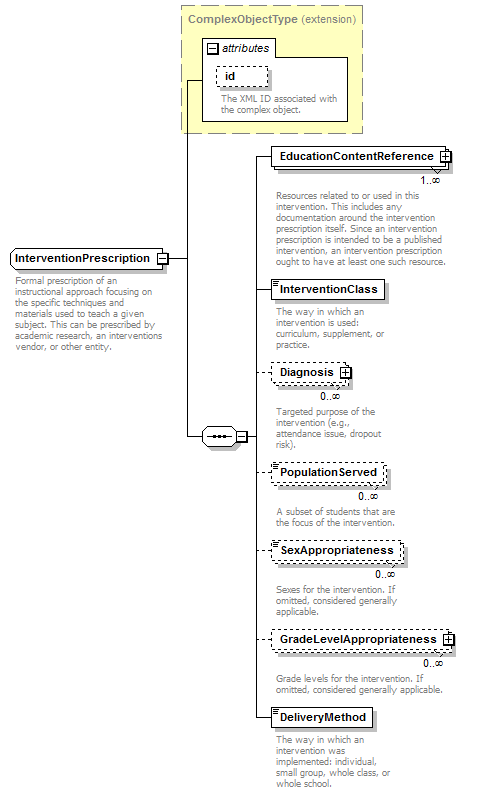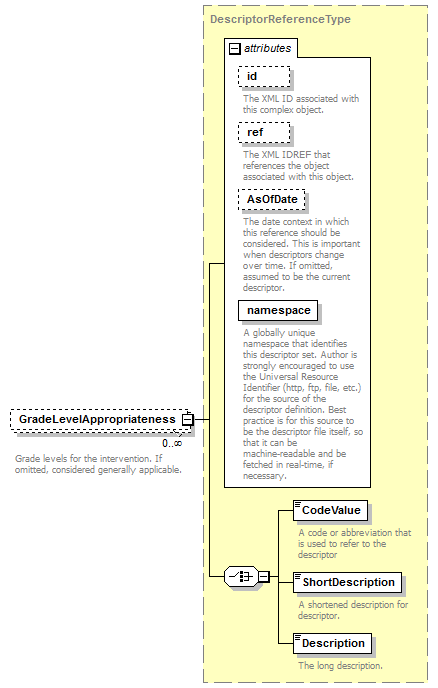complexType
InterventionPrescription
element InterventionPrescription/EducationContentReference
element InterventionPrescription/InterventionClass
element InterventionPrescription/Diagnosis
element InterventionPrescription/PopulationServed
element InterventionPrescription/SexAppropriateness
element InterventionPrescription/GradeLevelAppropriateness
element InterventionPrescription/DeliveryMethod
| diagram |  |
||||||||||||||
| namespace | http://ed-fi.org/0110 | ||||||||||||||
| type | extension of ComplexObjectType | ||||||||||||||
| properties |
|
||||||||||||||
| children | EducationContentReference InterventionClass Diagnosis PopulationServed SexAppropriateness GradeLevelAppropriateness DeliveryMethod | ||||||||||||||
| used by |
|
||||||||||||||
| attributes |
|
||||||||||||||
| annotation |
|
||||||||||||||
| source | <xs:complexType name="InterventionPrescription"> <xs:annotation> <xs:documentation>Formal prescription of an instructional approach focusing on the specific techniques and materials used to teach a given subject. This can be prescribed by academic research, an interventions vendor, or other entity.</xs:documentation> <xs:appinfo> <ann:TypeGroup>Domain Entity</ann:TypeGroup> </xs:appinfo> </xs:annotation> <xs:complexContent> <xs:extension base="ComplexObjectType"> <xs:sequence> <xs:element name="EducationContentReference" type="EducationContentReferenceType" maxOccurs="unbounded"> <xs:annotation> <xs:documentation>Resources related to or used in this intervention. This includes any documentation around the intervention prescription itself. Since an intervention prescription is intended to be a published intervention, an intervention prescription ought to have at least one such resource.</xs:documentation> </xs:annotation> </xs:element> <xs:element name="InterventionClass" type="InterventionClassType"> <xs:annotation> <xs:documentation>The way in which an intervention is used: curriculum, supplement, or practice.</xs:documentation> </xs:annotation> </xs:element> <xs:element name="Diagnosis" type="DescriptorReferenceType" minOccurs="0" maxOccurs="unbounded"> <xs:annotation> <xs:documentation>Targeted purpose of the intervention (e.g., attendance issue, dropout risk).</xs:documentation> <xs:appinfo> <ann:Descriptor>DiagnosisDescriptor</ann:Descriptor> </xs:appinfo> </xs:annotation> </xs:element> <xs:element name="PopulationServed" type="PopulationServedType" minOccurs="0" maxOccurs="unbounded"> <xs:annotation> <xs:documentation>A subset of students that are the focus of the intervention.</xs:documentation> </xs:annotation> </xs:element> <xs:element name="SexAppropriateness" type="SexType" minOccurs="0" maxOccurs="unbounded"> <xs:annotation> <xs:documentation>Sexes for the intervention. If omitted, considered generally applicable.</xs:documentation> </xs:annotation> </xs:element> <xs:element name="GradeLevelAppropriateness" type="DescriptorReferenceType" minOccurs="0" maxOccurs="unbounded"> <xs:annotation> <xs:documentation>Grade levels for the intervention. If omitted, considered generally applicable.</xs:documentation> <xs:appinfo> <ann:Descriptor>GradeLevelDescriptor</ann:Descriptor> </xs:appinfo> </xs:annotation> </xs:element> <xs:element name="DeliveryMethod" type="DeliveryMethodType"> <xs:annotation> <xs:documentation>The way in which an intervention was implemented: individual, small group, whole class, or whole school.</xs:documentation> </xs:annotation> </xs:element> </xs:sequence> </xs:extension> </xs:complexContent> </xs:complexType> |
element InterventionPrescription/EducationContentReference
| diagram |  |
||||||||||||||||||||||
| namespace | http://ed-fi.org/0110 | ||||||||||||||||||||||
| type | EducationContentReferenceType | ||||||||||||||||||||||
| properties |
|
||||||||||||||||||||||
| children | EducationContentIdentity | ||||||||||||||||||||||
| attributes |
|
||||||||||||||||||||||
| annotation |
|
||||||||||||||||||||||
| source | <xs:element name="EducationContentReference" type="EducationContentReferenceType" maxOccurs="unbounded"> <xs:annotation> <xs:documentation>Resources related to or used in this intervention. This includes any documentation around the intervention prescription itself. Since an intervention prescription is intended to be a published intervention, an intervention prescription ought to have at least one such resource.</xs:documentation> </xs:annotation> </xs:element> |
element InterventionPrescription/InterventionClass
| diagram |  |
||||||||||||
| namespace | http://ed-fi.org/0110 | ||||||||||||
| type | InterventionClassType | ||||||||||||
| properties |
|
||||||||||||
| facets |
|
||||||||||||
| annotation |
|
||||||||||||
| source | <xs:element name="InterventionClass" type="InterventionClassType"> <xs:annotation> <xs:documentation>The way in which an intervention is used: curriculum, supplement, or practice.</xs:documentation> </xs:annotation> </xs:element> |
element InterventionPrescription/Diagnosis
| diagram |  |
||||||||||||||||||||||||||||||||||||||
| namespace | http://ed-fi.org/0110 | ||||||||||||||||||||||||||||||||||||||
| type | DescriptorReferenceType | ||||||||||||||||||||||||||||||||||||||
| properties |
|
||||||||||||||||||||||||||||||||||||||
| children | CodeValue ShortDescription Description | ||||||||||||||||||||||||||||||||||||||
| attributes |
|
||||||||||||||||||||||||||||||||||||||
| annotation |
|
||||||||||||||||||||||||||||||||||||||
| source | <xs:element name="Diagnosis" type="DescriptorReferenceType" minOccurs="0" maxOccurs="unbounded"> <xs:annotation> <xs:documentation>Targeted purpose of the intervention (e.g., attendance issue, dropout risk).</xs:documentation> <xs:appinfo> <ann:Descriptor>DiagnosisDescriptor</ann:Descriptor> </xs:appinfo> </xs:annotation> </xs:element> |
element InterventionPrescription/PopulationServed
| diagram |  |
|||||||||||||||||||||||||||||||||
| namespace | http://ed-fi.org/0110 | |||||||||||||||||||||||||||||||||
| type | PopulationServedType | |||||||||||||||||||||||||||||||||
| properties |
|
|||||||||||||||||||||||||||||||||
| facets |
|
|||||||||||||||||||||||||||||||||
| annotation |
|
|||||||||||||||||||||||||||||||||
| source | <xs:element name="PopulationServed" type="PopulationServedType" minOccurs="0" maxOccurs="unbounded"> <xs:annotation> <xs:documentation>A subset of students that are the focus of the intervention.</xs:documentation> </xs:annotation> </xs:element> |
element InterventionPrescription/SexAppropriateness
| diagram |  |
|||||||||
| namespace | http://ed-fi.org/0110 | |||||||||
| type | SexType | |||||||||
| properties |
|
|||||||||
| facets |
|
|||||||||
| annotation |
|
|||||||||
| source | <xs:element name="SexAppropriateness" type="SexType" minOccurs="0" maxOccurs="unbounded"> <xs:annotation> <xs:documentation>Sexes for the intervention. If omitted, considered generally applicable.</xs:documentation> </xs:annotation> </xs:element> |
element InterventionPrescription/GradeLevelAppropriateness
| diagram |  |
||||||||||||||||||||||||||||||||||||||
| namespace | http://ed-fi.org/0110 | ||||||||||||||||||||||||||||||||||||||
| type | DescriptorReferenceType | ||||||||||||||||||||||||||||||||||||||
| properties |
|
||||||||||||||||||||||||||||||||||||||
| children | CodeValue ShortDescription Description | ||||||||||||||||||||||||||||||||||||||
| attributes |
|
||||||||||||||||||||||||||||||||||||||
| annotation |
|
||||||||||||||||||||||||||||||||||||||
| source | <xs:element name="GradeLevelAppropriateness" type="DescriptorReferenceType" minOccurs="0" maxOccurs="unbounded"> <xs:annotation> <xs:documentation>Grade levels for the intervention. If omitted, considered generally applicable.</xs:documentation> <xs:appinfo> <ann:Descriptor>GradeLevelDescriptor</ann:Descriptor> </xs:appinfo> </xs:annotation> </xs:element> |
element InterventionPrescription/DeliveryMethod
| diagram |  |
|||||||||||||||
| namespace | http://ed-fi.org/0110 | |||||||||||||||
| type | DeliveryMethodType | |||||||||||||||
| properties |
|
|||||||||||||||
| facets |
|
|||||||||||||||
| annotation |
|
|||||||||||||||
| source | <xs:element name="DeliveryMethod" type="DeliveryMethodType"> <xs:annotation> <xs:documentation>The way in which an intervention was implemented: individual, small group, whole class, or whole school.</xs:documentation> </xs:annotation> </xs:element> |
